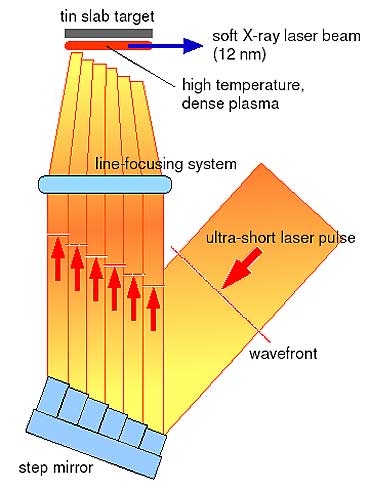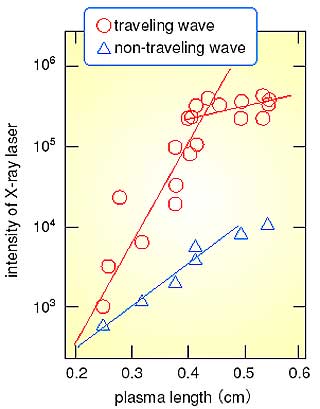We developed a new pumping method to realize more efficient soft X-ray amplification of a nickel-like tin laser at a wavelength of 12 nm (nm=10-9 m) in which substantial amplification already has been observed. In typical X-ray laser experiments, highly charged ions in a high-temperature dense plasma column having a 5-6 mm length are used as a gain medium. This plasma column is generated by a few ps (ps=10-12 s) pumping laser pulse irradiating a slab target. However, with a decrease in electron temperature, amplification is reduced. When the gain medium is composed of nickel-like tin ions, the lifetime of the amplification gain is around 5 ps, which corresponds to a light propagation length of 1.5 mm. Thus, when the amplified X-rays propagates in the gain medium from one edge to the other, the amplification gain of the gain medium is lost before the amplified X-rays reach the other edge, and strong amplification is obstructed.
To overcome this difficulty, we have employed a step mirror in the focusing system
to tilt the wavefront of the pumping laser light (Fig. 8-1). This pumping method
is called traveling-wave pumping. The step mirror, specially made for this experiment,
consisted of six blocks, each 25 mm wide. All blocks are mounted on a 150x150
mm base-plate. This step mirror divides the pumping laser pulse, and each laser
pulse component reaches the target with the appropriate temporal delay. By optimizing
the steps of each mirror component, we can adjust the temporal delays. This makes
it possible to amplify the X-rays propagating the gain medium under optimum conditions.
Fig. 8-2 shows the amplification curve of the nickel-like tin lasers for both
the traveling-wave pumping case and the simultaneous pumping case. By use of traveling-wave
pumping, the gain coefficient was improved from 14 to 30 cm-1. We observed
gain-saturation at a gain medium length of 4.3 mm. A 15 mu J/pulse output energy
with an output intensity of 4x1010 W/cm2 under the gain-saturation condition provides the best performance, at the present time, in laboratory-size soft X-ray lasers. |


